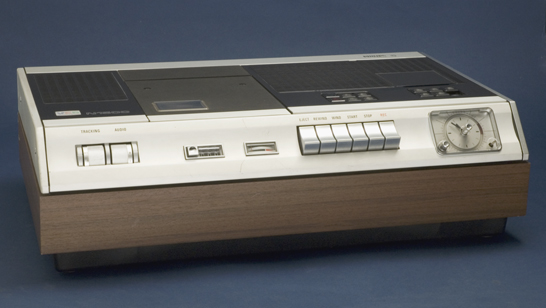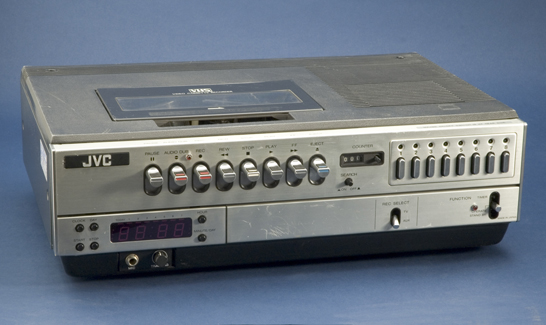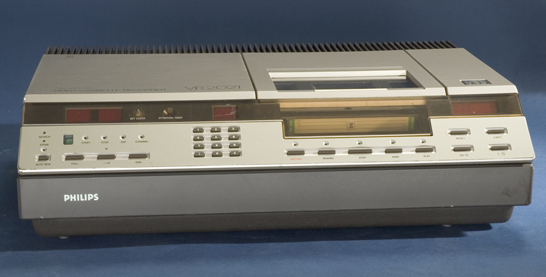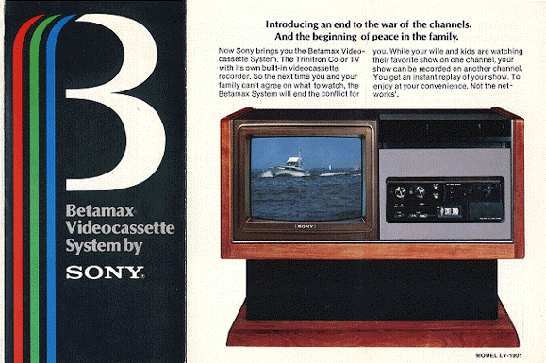An example of the first Betamax VCR sits in our collection stores. It’s a large wooden console with both a 19″ Sony Trinitron TV and a Betamax VCR. In 1975, the idea of video recording at home was unheard of to most people. Adverts for the first Betamax video recorder promised ‘an end to the war of the channels’ and ‘the beginning of peace in the family’.
The home videotape revolution was a major development in television’s history. The first video cassette recorder (VCR) to become available was not Betamax; it was the Sony U-matic (3/4″ tape) system, released in September 1971.
U-matic was really designed for commercial or professional television production use however, and was not affordable or user-friendly for home videos or home movies.
The first consumer-grade VCR, released in Britain the following year, was the Philips N1500. These units cost nearly £600 and their problem was that they were very unreliable due to the very thin video tape the format required.

In the 1970s, any recording of video at home was done with a video machine that was very expensive, if you could find one, and if you could afford one. Betamax would come to represent a major step towards getting video recording into the average home.
Sony made the first major attempt at this in 1975 with the LV-1901 console. This unit arrived in America two years before JVC’s Video Home System (VHS) in 1977 and four years before the Philips Video 2000 system (1979).


The first Betamax VCR ever, Sony Color TV Console LV-1901, was first introduced in Japan, arriving in America on the 10th of May, 1975 with a price tag of $2,495. Included was a 19″ Sony Trinitron TV plus a dual-chassis SL-6200 Betamax, all in a beautiful teakwood cabinet.

The integrated TV meant potential customers who already owned a colour TV would end up with two colour sets, or would have to sell their existing set. Since many households were still on the verge of the transition from black and white to colour, this wasn’t much of a problem. A few months later, Sony introduced their first stand-alone Betamax, SL-7200.
An example of the first Betamax home video recorder can be seen on the behind the scenes tours of our research centre, Insight. I acquired the set for the museum in mid-2011 from a very nice fellow in the Chicago area, the youngest son of the original owners, who recalled:
The machine was bought from a huge electronic warehouse that carried all types of SONY products called Polk Brothers, in Melrose Park, Illinois. I was 17/18 years old. The set cost around $2500.00, which at the time was huge! We were the first family that I knew among my friends or relatives that had the Sony VCR console, which had the Sony TV built in.
A fascinating if rather dated promotional/instructional video, entitled ‘The Flying Clouds’, came with the console. Customers unfamiliar with the idea of video recording clearly needed their hands held through the process.
http://www.youtube.com/watch?v=C0kFsXFafTQ
The first home Beta tapes available were only 1 hour duration, and these were quite expensive. Home movie rental on Beta cassettes had yet to become a viable business.
The set was strictly for recording from television. I don’t remember buying any movies on Beta at first. They might have come along later but we only recorded movies and TV shows. I remember when we recorded The Godfather, it took 9 tapes to record it. Another long series was Roots—that was 11 tapes.
Period advertisements for the set stated, ‘Until now you could only fight over what TV shows to watch, now you can also fight over what TV shows to record.’
I was a senior in high school and there were music videos on TV at midnight on Saturday night called Rockworld. I would record them and my friends would come over to watch them at midnight. The Betamax was in our living room so everyone had to be very quiet not to wake my parents upstairs.
Although Sony’s Trinitrons were commonplace in the UK by the mid 70s, LV-1901 Trinitron-Betamax consoles never made it to Britain. The reason for this decision by Sony is not known, however it may have been due to the cost of reconfiguration of the circuitry for PAL and 50Hz AC mains in relation to the number of LV-1901 units that they could expect to sell.
A popular Betamax VCR in Britain was the Sony SL-C7 (1979).

Standalone Betamax recorders were available in the UK by early 1977. Although Beta was superior to the competing VHS system, initial UK supply problems and higher costs would lead to Beta’s ultimate demise. Like VHS, the 1977 Betamax II machines (such as the Sony SL-8200) were now long play, offering around 3 hours of recording time.
Excellent article. We had the Sony SL-C7. Great machine, and technically vastly superior to any VHS devices. It was a shame that Betamax never had the studio support or consumer confidence to succeed.
It lasted well as a professional format though, and remember using Beta SP for CGI work at University in the late 90s.
I have one where would I sell it
It’s hard to believe how badly Sony planned the debut of Beta. Who would want a 1-hour recorder with no movies available and a mandatory 19″ TV, for the price of a small car (maybe a bit less). What if I already had a 25″ TV? Sony figured that if 1 hr was enough for U-Matic, it was enough for home video, which was extremely short-sighted.
And this was not the first time Sony tried to sell home video recorders – they had 1/2 reel-to-reel machines including a portable, available through the 1960s, which I believe cost less than $2500.
Still it does make for amusing history, thanks!
There were movies available on Betamax.
I am a service engineer based in North West London.
I specialise in the repairs of vintage hi fi and audio equipment.
I have a collection of around 20-25 VHS recorders, Sony, Toshiba, Panasonic etc, etc.
I also have a Toshiba V-8700 Betamax.
I am looking to donate them to a museum, rather than put them in landfill.
Would you be interested?
Dear Mr. Horowitz,
I have recently tried to get my old Sanyo beta 6800 working and have it where it will load and play tapes but no video any books or a place to start diagnosing the video it was working when stored over 15 yrs. ago …basically cleaned and replaced the mechanical parts and belts and it runs smooth.. any help would be deeply appreciated
Please help me.
I have been looking all over to purchase a Betamax Player with any success,please
help me. I live in south London
Thank you
Contact the bloke who posted immediately above your comment ( if you haven’t already ), he’s in North London.
A great article. I had a Grundig item – similar I think to the Philips.
I still have a ‘Surround Sound’ AKAI VCR. Basically it has a stereo amp inside, with sockets out to two extra speakers to put behind the viewer.
Superb machine, but now, like most vts’s, the abizmuth needs looking at.
Actually, I’m having to downsize now, so might be tempted to sell it.
Original carton etc.